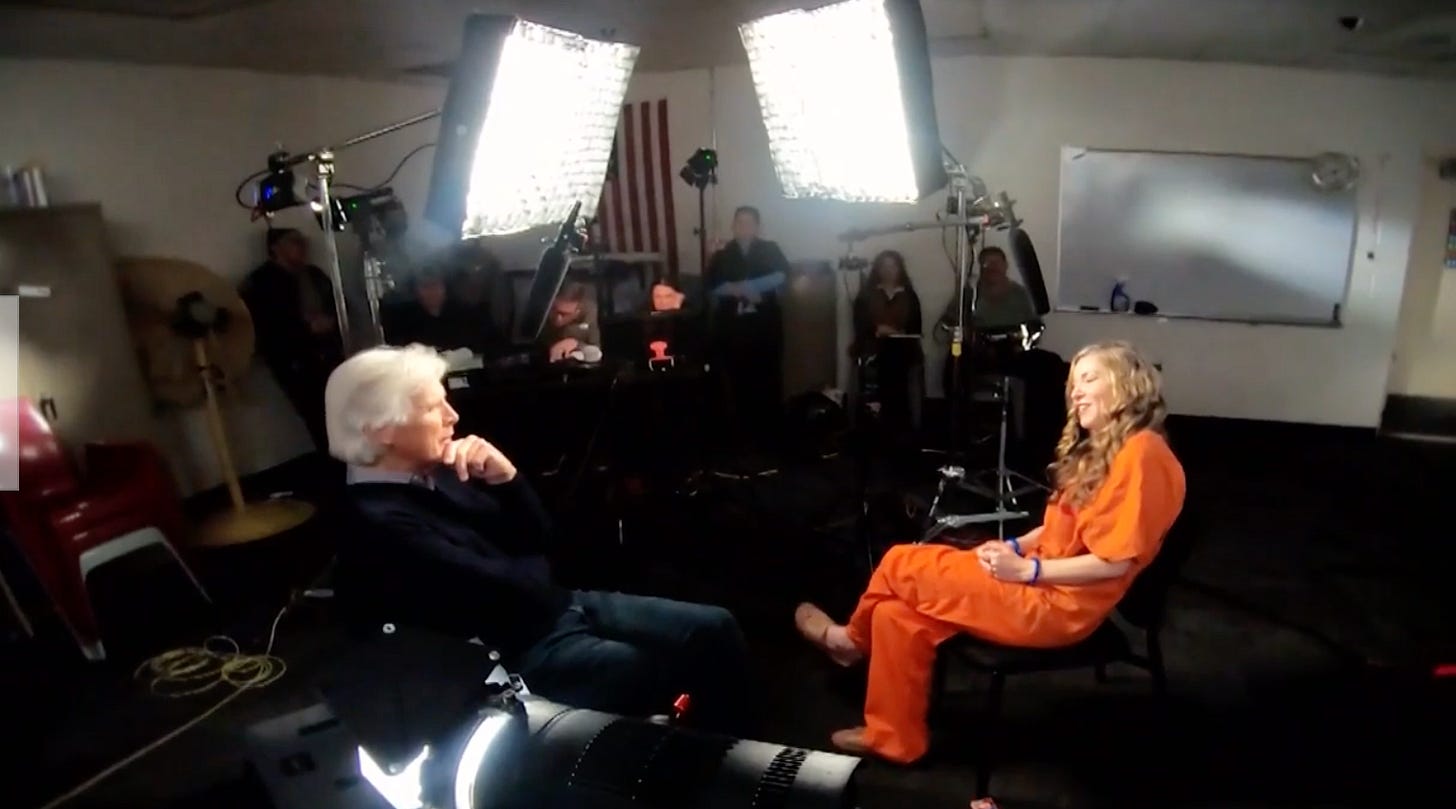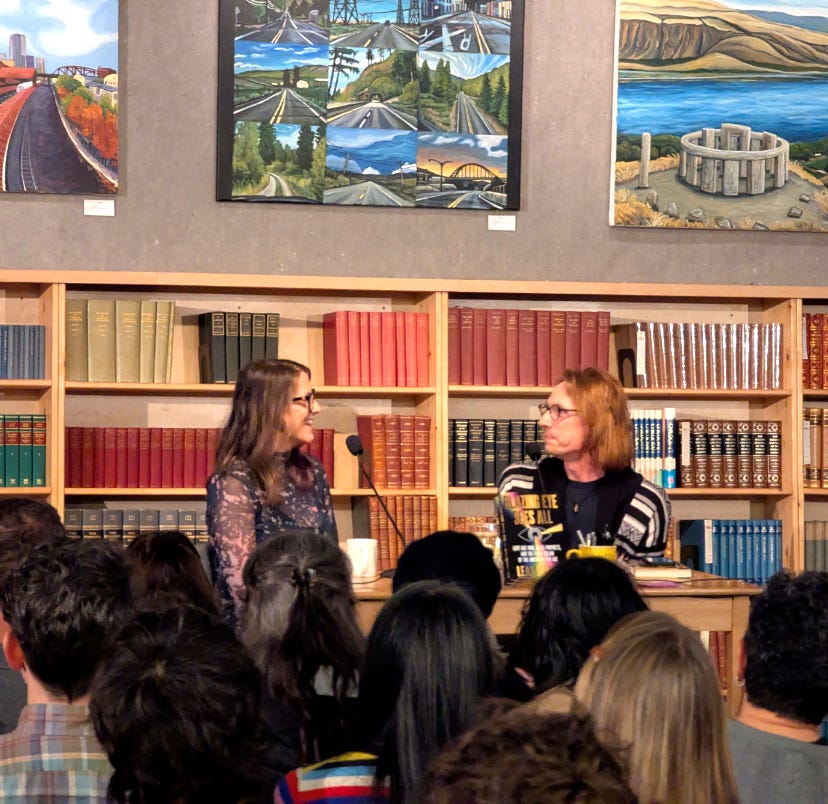THANK YOU so much for making Blazing Eye Sees All’s first week on shelves a hit!
What a week!1 I am so very proud of my new book, which had a lovely debut at Powell’s Books. I got to have a live conversation with my pal Toastie Oaster. C-SPAN filmed it all2 and the store put out every chair they had. It’s always so wonderful to meet people who read something I wrote a long time ago and have continued to support my work. And so many subscribers to this very newsletter were there! Amazing.3
A few more book notes before we get down to business:
"This Book Occurs At the Exact Place Where the Far-Right and Far-Left Meet"- I had the distinct privilege of answering Anne Helen Petersen’s questions about Blazing Eye Sees All for her newsletter,
.“From St. Agnes to Riot Grrrl to Tarot Cards: My Search for Rebellious Spirituality” - I wrote this personal essay this week, for Elle, about my own quest for spirituality that feels radical.
Spokane! I’m so excited to be a part of the Northwest Passages event on Wednesday evening. Tickets for 10 bucks can be bought here, but the event is free for students. (I’ll be posting other events soon on my website.)

When Lori Vallow walked into the room, she smiled. She laughed. She winked and joked about how hard it would be for her to talk with her hands anchored together in handcuffs. She was casual, not nervous. This was no game show or beauty pageant. It was Dateline. She carried herself the same.
Vallow4 was not ashamed of her orange jumpsuit, her shackled feet. This has been her outfit, and her situation, for the past five years: since she was arrested in Hawaii in 2020; since she was found guilty by an Idaho jury for the murders of her children and sentenced to three lifetimes in prison; since she was extradited to Arizona. This week a jury will be selected to judge the evidence against her in the first of two trials. She is charged with the conspiracy to murder her fourth husband. She will act as her own attorney.
On Dateline it appeared she was thinking of none of that as she basked in the gaze of television cameras, as if cameras are only pointed at subjects who have earned something.
A few weeks ago, Dateline began publicizing its exclusive 90-minute jailhouse interview with Lori Vallow — the first time she’s sat down with any reporter in the five years since this ordeal became known.
As the episode began and Vallow was escorted in by guards, Keith Morrison — who hosted the podcast that deemed Vallow as “Mommy Doomsday” — asked a rhetorical question of the audience in a voiceover: “Is giving attention to someone so notorious, who loves the limelight so much, a good thing?”
It’s a good question. What is the right kind of attention to give to a serial killer? By the end of the episode, Morrison seems not to know the answer to his own question.
This sit-down, however, is the latest in the long torrid legacy of the television serial killer interview. For as long as there have been TV cameras it also seems there have been interviews like this. The reporter stands in for all things moral. He is our conscience. The killer is the killer, and when the killer acts strange, the conscience is shocked. A person stands at the bars of a tiger’s cage at the zoo and grips the pearls at their neck when the animal rips the head off its prey, aghast at its lack of manners.
“You’re the most hated mom in America?” was an early question Morrison asked, to which Vallow laughed.
“I’ve heard that,” she said. “We all know what the media does. They exaggerate everything and they make stuff up and they twist things around. I don’t know how it became what it is today. It’s amazing to me.”
“Are you misunderstood?” Morrison asked.
“Absolutely,” she said.
“Misunderstood how?”
“In every way,” she said. “I mean, how do you know a person if you’ve never talked to them in five years? How do you know anything about them? How do you know anything about their life? About how it really is?”
This episode of Dateline runs one hour and twenty-three minutes. Very little of this interview makes it in. The episode is a re-hash: the retelling of the same story, this time with blips from the Vallow interview. I have never watched Dateline before, and am not convinced to do so from watching this one episode. Perhaps this is the format. I have no idea.
After I finished the episode, I started to watch other interviews with killers. Two had similarities to the way Vallow acted during her interview.
As a journalist, I was trying to understand what the function of these killer interviews is. One could argue that the serial killer sit-down is the media following through, getting all sides of a story.
To be fair: Vallow has not been completely silent. During her trial in Idaho, she chose not to take the stand and tell the jury the police were all wrong. At her sentencing before a judge, she offered comments about Jesus coming to her cell to speak to her, about her dead children telling her not to feel bad. Her comments, the judge said, only further proved the depth of her delusions.
But it seemed the media thought there was something more to get from her. Something that felt honest. Maybe they thought Keith Morrison could break through.
Instead, she had complaints. Complaints about the media.
She has this in common with Ted Bundy. In 1977, Bundy was interviewed in jail by TV reporters Barbara Grossman and Lucky Severson. He spoke of his innocence and his unwavering belief the epic frame-job leveled against him would be proven during a new trial. He blamed his victims. He did it with a smile. Breezy.
“Quite frankly, the amount of bias and prejudice that surrounds me as a media image I can’t begin to tear down,” he told Grossman. “Not with this interview or a hundred interviews.”
“Do you believe that we created you?” she asked Bundy. “That it’s our fault and we created this image of the mass murderer, is that what you’re saying to us?”
“Well, I think in the course of doing your job, you did,” he said, rubbing his beard. “Not in a malign way, not in a personal vendetta against me. But in the course of publishing the material, or broadcasting the material coming out … you began to plant the seed in people’s minds … you did create a media image of me that’s far beyond the reality of me.”
Charles Manson was a different kind of killer than Bundy — sometimes keeping his hands clean as his followers spilled blood for him, a similarity you could argue applies to Vallow as well. Why do the hard work when you can use other people as your weapon?In 1981, the TV reporter Tom Snyder sat down for a jailhouse interview with Manson. Well, Snyder sat; Manson paced.5
Snyder seemed to be there to poke the bear. “You love all the pain that you’ve caused people, all the anguish…?”
“Oh, oh I don’t know pain?” Manson shot back. “I have no depth of pain? I have no depth of suffering. I don’t ridicule. I don’t know all the bad things.”
“I haven’t killed anyone. I didn’t break the law,” Manson claimed. “The judge knew that but the people didn’t want to hear it…” He trailed off.
“What does mean you’re guilty?” Snyder wanted to know.
“When you know you’re guilty,” Manson said.
When he asked about killings, Manson seemed not to hear him. He seemed to detach from himself. Float away.
The interviews with Bundy and Manson ran long and unedited. To see the way the men conduct themselves was a story in itself: Bundy was calm and friendly, Manson raved, was quick to anger.
Flash forward in time to 2025, our latest killer interview comes in edited blips and soundbites. In some ways, Vallow echoed her killer counterparts: she said her tragedies had been turned into crimes by the media. (Bundy/Manson). She said she was trying to give the truth, but Morrison didn’t want to hear the truth. (Manson) She smiled (Bundy), flirted (Bundy), answered questions with questions (Manson).
Keith Morrison’s no amateur or stranger to high-profile interviews with murderers. So what was it about Lori Vallow that was so different? We get hints that the interview didn’t go the way Morrison planned, but we don’t see why. “Was this the real Lori, or was she playing a character? And playing me too — or trying to?” Morrison asked in another voiceover.
In what little we see of their conversation, Vallow seems to catch Morrison off-guard. To questions about murder, she responded “Really, Keith?”
When he challenged her, Vallow snapped back: “I thought we were going to be friends, Keith.”
Morrison tried being direct: “I’m asking you a question “did you watch your children die?”
“That’s a very sad question,” she said.
On an NBC segment introducing the episode, his colleagues expressed shock over how difficult she was to wrangle. They said Morrison looked flustered.
“Flustered is exactly what it was,” he said.
“How do you prepare for chaos?” he said. “She wanted to fill that entire 90 minutes we had with a long shaggy-dog tale about how her daughter killed her son and then killed herself … This is not possibly true.”
When you write and report on extremists, there are questions you ask yourself before you publish. If by doing the story, you must ask yourself if you have been manipulated into spreading a hateful ideology further. What is the news value of what you’re writing?
So what is the reason Dateline didn’t run an entire interview with Vallow? Was she so nonsensical, so all over the place, telling a story filled with such easily provable lies, the producers deemed it unworthy of airtime?
Media publishes other people’s lies all the time. Look at the lies that come from the White House. Those don’t get edited down, and at best are reported with caveats. So why edit Vallow? Was it because she blamed everyone who is a victim in this case? Was it because she pinned everything on her dead daughter, like she hinted in her comments at sentencing and in an interview with her son Colby?
Or was the reason to not run it in full simpler than that: was Lori Vallow so off-the-wall bananas, it just didn’t make any sense?
Or did she spout religious justifications the interviewer didn’t understand?
And did Keith Morrison honestly think he was going to get a confession out of someone who has never once hinted she understands contrition?
Vallow came to talk. At trial she had a microphone, and a moment, but it wasn’t big enough for her. She wanted lights and cameras. She behaved exactly as I would have expected. A lord of chaos. A ranter and a raver. What’s surprising is that Morrison thought he had a Bundy on his hands, when really he had a Manson.
Less than stellar week politically, socially, culturally, etc.
I’ll link to the video when it’s up.
Thank you to my high school friend Phil, who I have not seen since 1999, but returned my cassette of Fugazi’s In on the Kill Taker at the signing table at Powell’s. Public libraries and I agree: you can return something after 25 years.
Vallow, and her husband Chad Daybell, were the subjects of my first book, When the Moon Turns to Blood.
Notably, neither Bundy or Manson were cuffed and shackled like Vallow. The trust!






Glad you had a great time at Powell's, and I'm sorry to have missed it!